
| Twilit Grotto -- Esoteric Archives | Contents | Prev | Part 1 | Next | timeline |
This digital edition by Joseph H. Peterson, Copyright © 2000. All rights reserved.
You will need a Hebrew font installed to read this.
| J. KAUFFMANN, Frankfurt a. M. Burnstrasse, 41. ----- |
D. NUTT, London, 57-59, Long Acre, W.C. ----- |
The manuscript described in these pages will offer to the student of ancient and modern literature much information regarding that branch of learning which deals with the world of mystery, -- a theme which from time immemorial up to the present day has ever had a remarkable facination for the mind of man.
The substance of this work might, as far as concerns its practical value, be looked upon as a combination of folly and daring; but from another point of view, namely, that works of this kind were during the past sought after, studied and believed in, the MS. before us assumes a character of high importance.
The Essenes, mentioned by Josephus and Philo, had already introduced into their religious activity some elements of a mystic tendency, and the Terapeutae of Alexandria were not behindhand in this direction. Their healing-art consisted in the application of mystic formulae derived from the works of King [-8-] Solomon (Josephus, Antiq. VIII, ii, 5). We find traces of this mysticism as the background of the art of healing in the New Testament itself. In the Old Testament, of course, witchcraft is looked upon as an abomination; it is forbidden and punishable by death.
Nevertheless, the spirit of man ever groping about in the dark was wont at all times, before the dawn of civilisation, to thirst and search after that which was hidden and concealed. For the purpose of improving their condition or satisfying their aspirations, men longed to employ in the absence of all material visible means of help such methods as they considered to have supplied by the mystic world. Their aim at first was to alter their own conditions by means of such mystic practices; and any failure with which they met in the course of their operations, they attributed to their own personal defects and want of ability. Their faith in the methods which they adopted could not be shaken.
It was this very faith in the efficacy of their craft that gave the opportunity to many an impostor to mislead the simple honest folk who sought their aid; and these impostors, at least, had no cause to [-9-] complain that Fate had been unkind to them, and had not helped them to improve their lot in life.
In the New Testament (Acts VIII), it is true, the practice of open sorcery, personified in Simon Magus, is assailed; yet this yearning after the acquisition of the gifts of the world and the satisfaction of temporal happiness could not be quenched by means of religion proper, and the unbeliever continually resorted to the practice of sorcery in order to bring about, as he thought, the amelioration of his condition.
In the Alpha-Beta of Ben Sira there is also cited an interesting instance of the practical application of the magic art (Amsterdam Edit. 1696, p. 9; the reference is to Nebuchadnezzar).
The Talmud (Sanhedrin 67b.) calls sorcery the "denial of the Providence of God": --
:äìòî ìù àéìîô ïéùéçëîù íéôùë ïîù àø÷ð äîì ïðçåé éáø øîà
A strong indictment against the practice of magic is contained in the later, though most important work íéãéñçä øôñ by Jehuda Hasid.
The concluding paragraph of this work is as follows: --
ìïåâë ñäá äøâúîù éîá àìà ïéøâúî ïé÷éæîä ïéà
åà úåòáùäáå íéôùëá å÷ñò åà úåòéî÷ åéúåáàå: àåä åáäëù
ìéáùá äùòà øîàé àìå íäá íãà ÷åñòé àì ïëì íëç úåìàùá
åéîé øö÷î àåä éë äîëç äæ ïéà éë 'òéî÷å úåòëùäá ùôð çå÷éô
åì ïéàå äéäú íéîú øîàâå ùôð éðôî ùôð' ïéçåã ïéàå åòéæ ééçå
åâì øùà ìë úàå åðòøæå åðøîùå 'äå ìëä ìò íéðåðçúå äìôú àìà
:ïîàå ïîà íìåò ãòå äúòî òø ìëî
[-10-]
Sorcery continued to florish during the centuries down to the middle ages and later times. It often, even in modern days, raised altars upon which human beings were offered as victims. We have but to think of the various trials on the ground of sorcery and witchcraft recorded in the annals of European nations.
The chief work which is supposed to have served as the oracle of all sorcerers throughout history is the famous "Clavicula Salomonis".
King Solomon who, according to tradition, was king of the whole world, and who, according to the statement in Ecclesiastes, could render all the joys and delights of life subservient to his will, stood forth as the pattern and prototype for all who hankered after the things which they regarded as the pleasurable and desirable objects of existence.
The legend runs that it was by means of magical conjurations that King Solomon the Wise was enabled [-11-] to procure for himself all delights and pleasures in which he indulged. A glance at the work ÷ùçä øòù (Livorno, 1790) by the renowned Johanan Allemanno (XV. cent.), and at the Responsum of R. Jacob Provenciale, 1490. (in the collection ëíéîëç éøáã by Elieser Ashkenasi, Metz, 1848), is sufficient to inform us as to the number of apocryphal works ascribed to King Solomon.
Gedaliah Ibn Jahya in his book "Shalshelethhakabala" (Ed. Venice, 1587, f. 98b.), in referring to such works, cites by name äîìù äúôî -- the very equivalent of Clavicula Salomonis. His words are as follows:

In the words of a modern non-Jewish scholar, to whom we shall presently refer by name: --
"Solomon plays the same role in ancient Jewish Magic as Faust does in the Christian; it is, therefore, not to be wondered at that books on magic are attributed to him. In addition to the famous Clavicula Salomonis, the following works are ascribed to him: -- Liber quatuor annulorum; Liber [-12-] de IX Candariis; Liber de tribus Figuris Spirituum and de Sigillis ad Dæmoniacos; Clavicula Salomonis ad filium Roboam; Liber Lamene; Liber Pentaculorum; Liber de officiis Spirituum; Hygromantia ad filium Roboam; Testamentum Salomonis; the Book Rasiel; the Book Almandal, etc. Compare the writings of Roger Bacon, Agrippa, Tritheim, Wier, Golast, Naudé, Horst, etc. in which the magic works of Solomon are mentioned and discussed."
The book "Clavicula Salomonis" may originally ages ago have been written in Hebrew by some unknown author; a cruel fate overtaking both the sorcerer and his works, and completely destroying the original manuscript of the said "Key". In later times what is supposed to be various translations of it have appeared in the Romance languages.
Karl Engel, the great scholar of the Faust legend, in his work Zusammenstellung der Faust-Schriften von 16 Jahrhundert bis Mitte 1884. Oldenburg, 1885 (§ VI Salomo, 443 sqq.), has enumerated the various editions of the Clavicula, which have hitherto appeared. They are as follows:
In addition to these included in Karl Engel's list, other printed works, versions of the Clavicula, are to be found in the British Museum, e.g: --
The British Museum has also amongst its treasures seven MSS. in
the Latin, French and Italian languages. They are Add. MSS. 10,862;
Sloane MSS. 1307 and 3091; Harleian MSS. 3981; King's MSS. 288;
Lansdowne MSS. 1202 and 1203. Of these Nos. 288 and 3981 are French
translations of the Italian made from the Hebrew by Abraham Colorno;
a copy (in Italian) is according to Ben Jacob's bibliographical
work  (s.v.
(s.v.  ), in the possession of Professor Stemschneider.
), in the possession of Professor Stemschneider.
In 1889 Mr. S. Liddel Macgregor Mathers, author of the "Kabbalah unveiled", by piecing together these various MSS. contained in the British Museum, edited "The Key of Solomon the King (Clavicula Salomonis)".
A hurried survey of these very MSS. might easily convince one that they are anything but Jewish in character, several of them containing illustrations which, in the eye of the Jewish Law, would be regarded as blasphemous: the human face or more extended form appears in a circle with the words éãù ìà added, the face itself in several instances being even supplied with horns and the form with wings.
[-15-]
With regard, however, to the Hebrew text itself, it seemed, as far as our knowledge went, to be altogether lost, so that, in recent times, no one troubled to make a search for it. In fact, it was given up as lost (Cf. Mathers, p. V.)
Without entering into the reasons for the utter disappearance of the work in the original, might it not be found in the fact that in recent centuries the book had lost its value for the sorcerer, and had an interest simply for the antiquarian student and the folk-lorist?
As late, however, as in the Faust legend -- child of Teutonic soil and of Romance and Slavonic adoption, the Clavicula served as the primary source of the Magic Art which figures so prominently in the legend itself.
To come now to the MS. which we are about to describe, and of which I propose to give an outline, I have lately had the good fortune to become possessed of what appears to be (as far as I am able to judge) a Hebrew Manuscript of the "Clavicula Salomonis", until this supposed to have been lost. I came across the volume while searching among the books contained in the library left by my late father, the [-16-] Reverend Samuel Marcus Gollancz.*
* My thanks are due to the eminent bibliographer, Mr. S. Chait, for kind help in this description of the MS.
Judging from the Appendices and probably later Title-page, the MS. seems to have been copied in the year 1700. There is little doubt that the copyist had an older MS. before him; he frequently adds corrections and variants, the result of his own criticism. It often seems that in making such corrections he employs the expression ì''ðë é'ôé øîà, and once (f.54b) he writes as follows: çéðä äæ øçà é''ôé
... We might clearly infer from these words that the writer was copying an older text.
Our MS. consists of 72 quarto leaves of one pagination and 7 leaves of a second pagination, 157 pages in all. The writing is in the Hebraic-Italian hand, the MS. itself being supplied with numerous illustrations. It would appear that the copyist endeavoured to do his work as carefully as possible, inasmuch as he now and again when making a bad drawing confesses to his want of artistic skill, and repeats his attempt at drawing the same figure on the opposite page.
[-17-]
The MS. has the following title page:
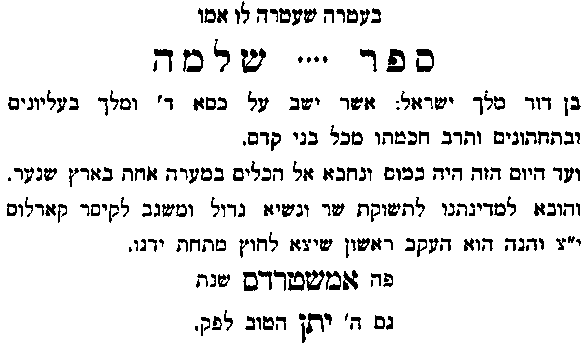
The word between øôñ and äîìù indicated by dots cannot be said to be "illegible," for it has been cut out evidently with a purpose, probably from fear: for it should be borne in mind that a book bearing the title äîìù äúôî ´ñ "Clavis" or "Clavicula Salomonis" might have involved, even at the time of the latest copyist, in most unpleasant and perhaps serious consequences, both the copyist as well as the possessor.
One has but to look back to the end of the 17th century and to the beginning of the 18th, and to think of the proceedings at the Trials, and the death sentences in connection with witchcraft and sorcery. (Cf. Dr. Jaraczewski's Vortag über Hexenprocesse [-18-] in Erfurt u. Umgegend, Erfurt, 1876, and the account of Jane Wenham's Trial at the Assizes at Hereford and Condemnation to Death, London, 1712).
The general impression conveyed by a perusal of the work itself is that it is perfectly Jewish in tone. The invocations and names contained therein, and the pantheistic spirit underlying the invocations as well as the formulae are not un-Jewish. The Jewish character of the work as a whole is not affected by the foreign elements and names introduced in the appendices and other parts. As an example, I will but cite here one point contained in a passage found in folio 46a. In the reply of "Bilath" the expression occurs éúøæò ìà, which proves that this demon, instead of being the enemy of God, is in reality subservient to His Will in reducing the sinning creature.
This is certainly Jewish in spirit, since the Christian idea of Lucifer is that of a rebel cast out of Heaven. If, for example, the invocation were Christian, the author would not have inserted a phrase so contrary to his own doctrine.
According to all appearances, the Magic Book "Clavicula Salomonis" was composed in the East. [-19-] And it is not at all unlikely that our MS., in spite of obviously late additions introducing in the appendix of the work the names of Prague and Vienna, may have been brought from the East into Europe by those turbulent spirits who acknowledged a Magician as the Messiah and followed him. Strange to say, there occurs in the appendix to our MS. one passage (fol. 6a.) which would seem to favor this theory, for it leads us on to a perfectly new track, namely, to the times of the dreamer and pseudo-Messiah, Sabbatai Zevi. In a variant incorporated in the text, the very name éúáù (Sabbatai) introduced by the abbreviation à''ð seems to occur. The name íåìù 'ø (fol 6b.) also points to the same origin.
Several times the word "Tetragrammaton", the Greek equivalent of JHVH, is used in this MS; this substitution in the Jewish Cabbala was adopted solely by Sabbatai Zevi and his party; (Cf. "Beth Hamidrash." Weiss, article by N. Brull, pp. 63 and 103).
The MS. begins thus:


[-21-]
Then follow seven "Prayers" (úåìôú) in pure Hebrew with here and there a Cabbalistic name.
I give the first two as specimens:

The 8th "Prayer" contains simple Cabbalistic
names.
The 9th consists of but one line.
The 10th is missing.
The 11th consists of two lines of Cabbalistic names.
The 12th to the 18th have simply the opening
words, with 'åëå
i.e. "etc." added, thus clearly referring to Prayers
or Invocations well known, and contained in fuller and older MSS.
The 19th to the 22nd are complete, but consist solely of Cabbalistic names.
The 23rd has but one word, with 'åëå added.
The 24th is complete: only Cabbalistic names.
[-22-]
The 25th and 26th have but one introductory Cabbalistic word.
Folio 3a has:

Folio 3b has the heading  ,
,
and continues the subject for four pages till 5b.
Folio 5b almost begins with the heading  , continuing till 6a
which contains 2
, continuing till 6a
which contains 2  , the first termed
, the first termed  .
.
Folio 6b has another "Prayer" in pure Hebrew beginning thus:

F. 6b. continues: 
This passage gives us important information concerning the Title
of the book. We have for the first time in the body of the MS.
the term  , equivalent to "Clavis".
, equivalent to "Clavis".
Following these introductory words comes this passage: --

[-23-]

In this paragraph the following regulation or order occurs:

Folio 7a. 
Folio 7a. 8b. 
Folio 8b. 
"
"
Folio 9a. 
Consists of Cabbalistic names." End of the prayer said prior
to effecting the charm.

The following passage occurs in this paragraph:

[-24-]
Here follows the manner in which the 3 associates are to be conjured, as well as the conjuration in the case of the dog.
As regards the latter we have the following regulation:
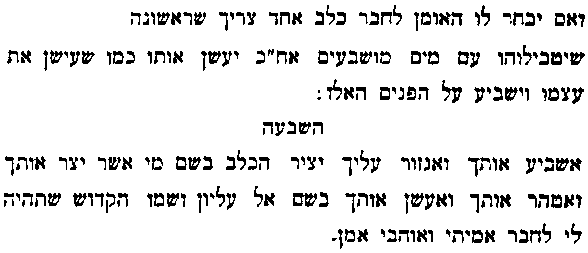
Folio 9b. 10a. 
If the associate be a boy or girl.
Folio 10a. 
Folio 10a. 
The associates to be 3, 5, 7, or 9, exclusive of the magician himself.
Folio 10b. Two prayers. 
Folio 10b.-11a. 
Concerning the 9 days' preparation for the act of conjuration.
Folio 11a-11b. 
The ablution and recital of certain Psalms.
Folio 11a.-11b. 
[-25-]
Folio 11b.-12b. 
Folio 12b.-13a. 
Folio 13a.-13b. 
In this paragraph mention is made of all the vessels and instruments required in the act of effecting a charm, the incense burner, writing materials, etc.
Folio 13b.-14a. 
Folio 14a. 
Folio 14a.-15a. 
Folio 15a. 
Folio 15a.-15b. 
Folio 15b.-16a. 
Folio 16a. 
Folio 16a.-16b. The following words enclosed in brackets show that our MS. is a copy:
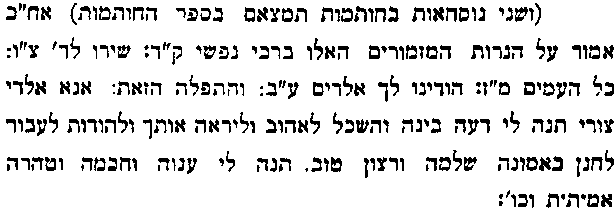
Folio 16b.-17a. 
Folio 17a. Of taking the blood of the bat. 
[-26-]
In this section occurs:- 
Folio 17a.-18b. 
Folio 18b.-19a. 
Folio 19a.-19b. 
Folio 19b.-20a. 
Folio 20a. 
Folio 20a. 
Folio 20a. 
Folio 20b. 
Folio 20b. 
Folio 21a-23a. 
5 pp. of symbols and figures.
Folio 23b. 
This heading is inserted by some later hand.
The beginning of the next section is:

Then 
Folio 23b-24a.

[-27-]
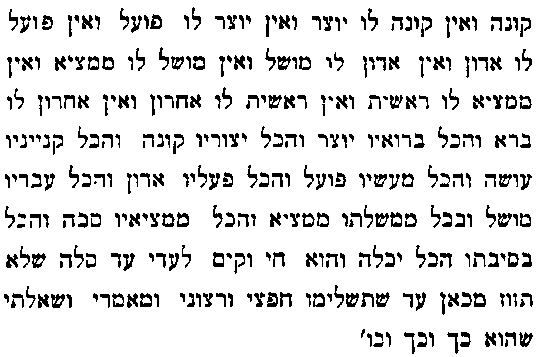
The whole passage is highly interesting, containing among others a conjuration of the "twelve families that came from Heaven to Earth on the day on which was born the son of the Great Satan -- your father!"
Again, 2 lines from the bottom of F. 24a. we read:--
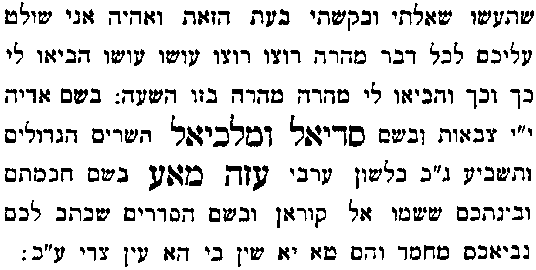
Referring as this passage does to the Koran and Mohammed, have
we not here the terminus a quo for the work itself?
| Twilit Grotto -- Esoteric Archives | Contents | Prev | Part 1 | Next | timeline |
Shelf mark: Harvard College Library Hebraica KH0164 1 of 1